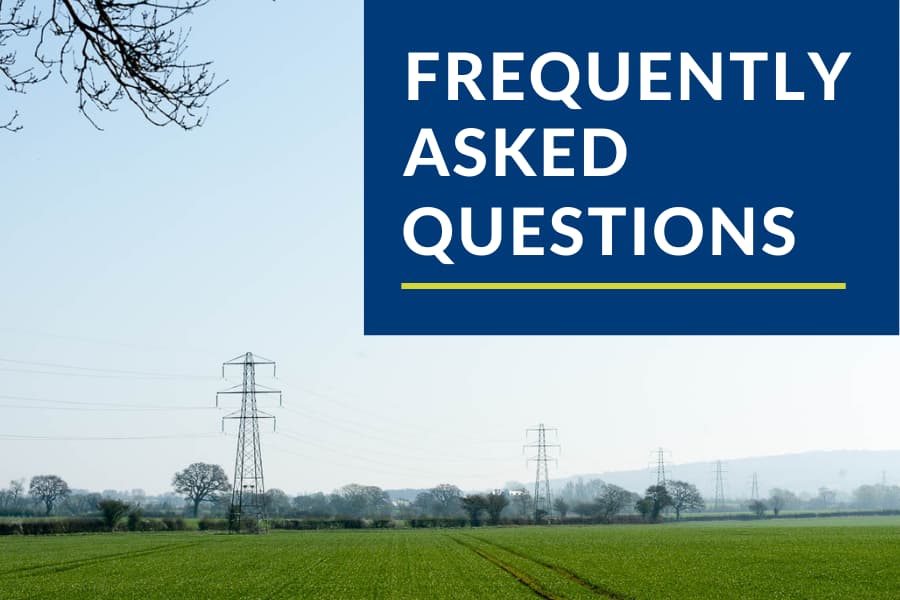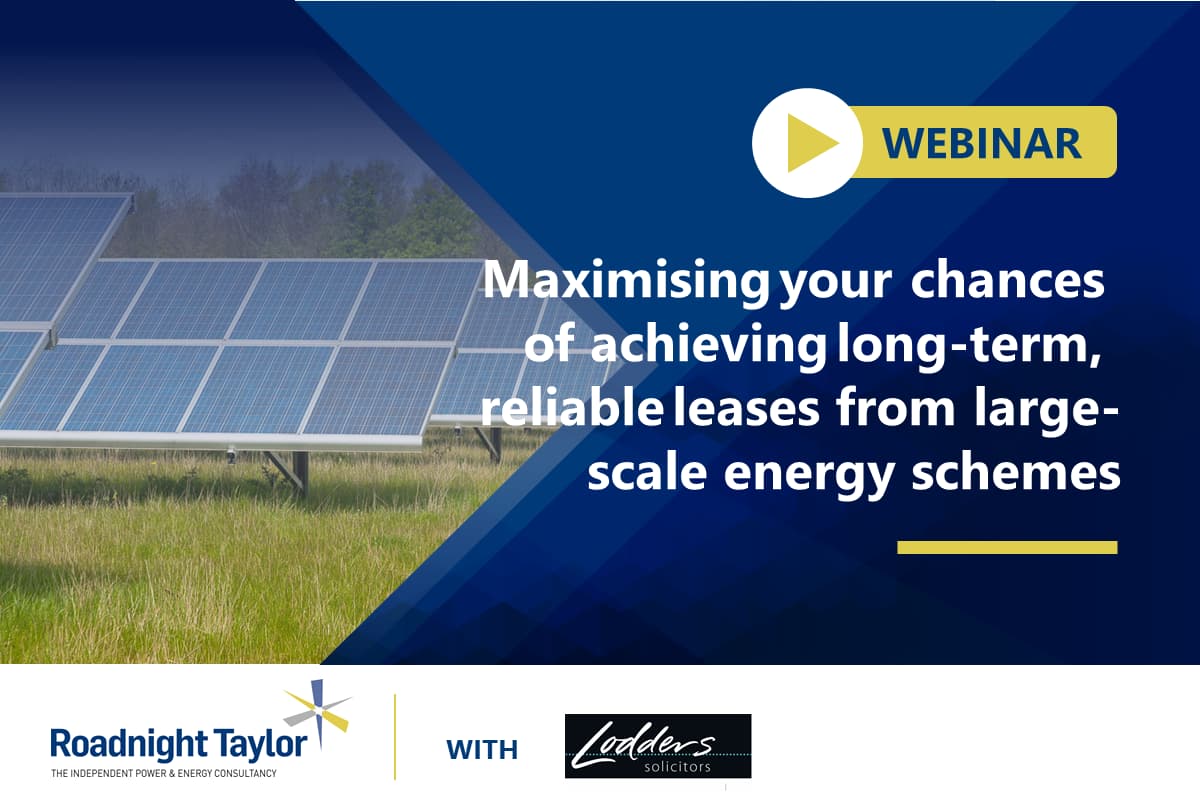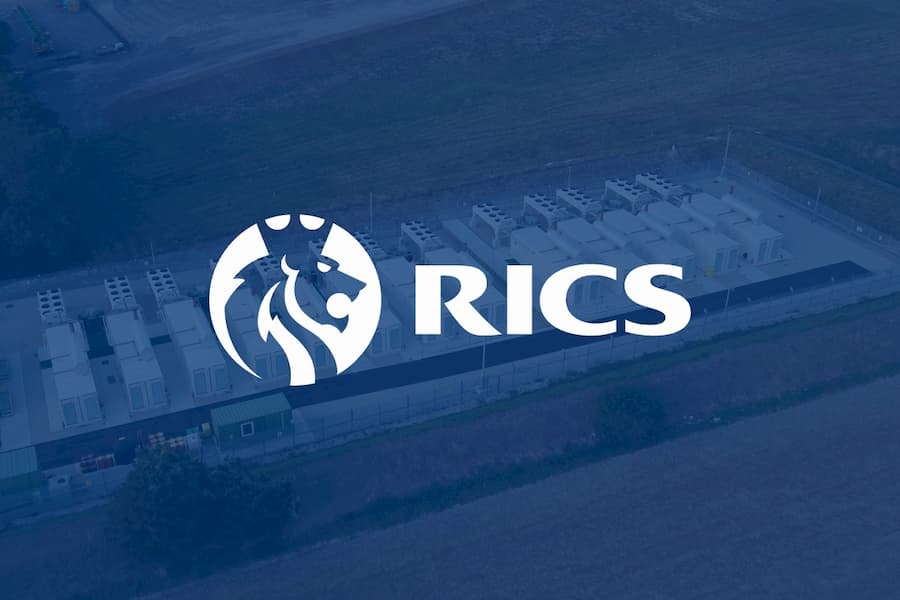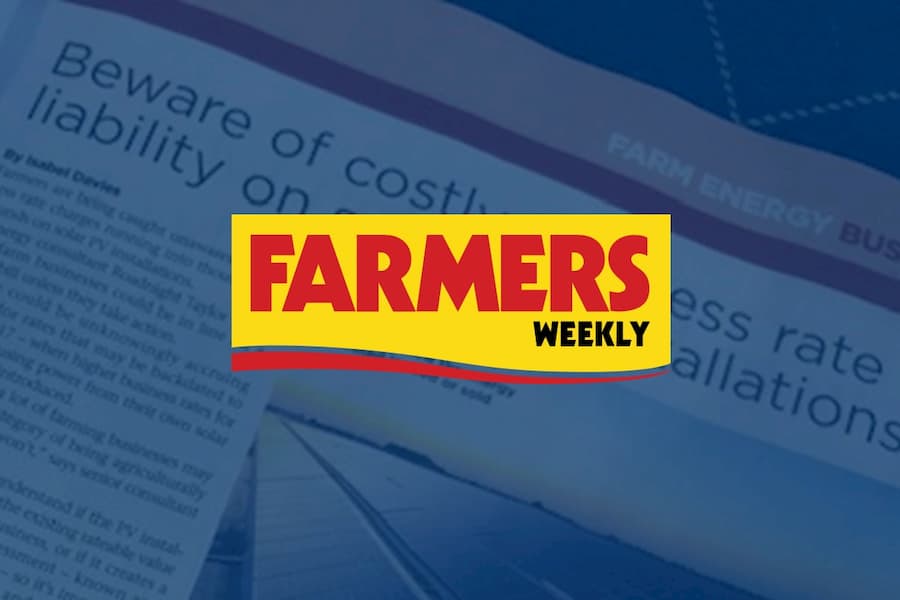Farm diversification income from energy projects – frequently asked questions
September 2020 (updated September 2022)
As rural landowners look to diversify and tackle economic and environmental challenges, energy schemes can offer those with viable sites an excellent income opportunity. Many landowners are exploring their potential, and some are lucky to secure high-paying schemes.
We’ve compiled a list of answers to the most common questions we get asked to help landowners decide if they should explore opportunities for themselves.
What are the renewable energy technology options and returns?
Solar
The developer community is now predominately focussing on large-scale solar. Depending on your site, you can expect ground rents of over £850 per acre for solar leases of 30 to 50 years. The vast majority of proposed solar sites are in the 40 to 180-acre range, with opportunities for most landowners being for smaller projects of 40-100 acres, connected at 33,000 volts.
Battery storage
The markets and associated revenues for battery storage are recovering, albeit gradually, after an oversupply of sites, and corresponding cooling of appetites, in 2017. Good battery storage sites can attract ground rents of over £100,000 per year. A typical battery storage scheme is up to two acres comprising multiple, 40-foot shipping style containers.
Solar plus storage
The greatest appetite is for solar-plus-storage. From a landowner’s perspective, ground rents reflect the aggregate of both the solar land-take and the megawatts of storage that can be deployed. For example, a very good 50MW solar-plus-storage site may attract £1,000 per acre for solar land (some 180 acres), as well as £2,000 per megawatt of storage – up to circa £280,000 per annum rent, in aggregate.
Gas
Gas gensets draw natural gas from the gas grid and combust this in reciprocating engines to generate energy, capturing peaks in power prices and delivering “flexibility services” to National Grid and local network operators. Whilst sites for large schemes of up to 50MW have been very attractive to developers in the past, there is now greater demand for smaller sites of 2MW-7MW with connection opportunities at 11,000 volts. These are typically well under and acre and command ground rents of cira £3,000 per megawatt, per annum.
I have three-phase electricity on site. Is that OK?
These large schemes need access to the 11,000 volt (11kV) network, as a minimum, and run separately to the low voltage three-phase circuits. Even if you don’t have power lines on poles or pylons crossing your land, you may still be closer than you think to an appropriate circuit.
The best sites are close to a 132,000 volt (132kV) circuit, 33,000 volt (33kV) circuit or have a primary substation (typically 33/11kV), a bulk supply point (typically 33/132kV), or grid supply point (typically 400/132kV) nearby. However, smaller schemes, typically up to 8MW, are better connected at 11kV and ideally, but not crucially, will be under one kilometre from a primary substation.
We can identify these network assets using our local mapping tools and can see if there are underground power lines close by that you may not be aware of.
What planning and location factors do I need to consider?
There are many ‘non-grid’ factors to consider, not least access, wayleaves/easements, and planning considerations such as existing use, proximity to dwellings, visibility, noise, landscape/habitat designations and flood risk.
I hear that the electrical grid is constrained. Is there capacity in my area?
Any energy scheme needs rights to connect to the electricity grid. There must be enough space (grid capacity) on the local network to export sufficient power – and a battery storage scheme also needs import capacity.
Don’t be put off by an apparent lack of grid capacity. It’s changing all the time and pockets of grid capacity are available in most parts of the country. Failed projects release capacity and the network operators are reconfiguring networks, or monitoring them in real time, to enable new ones. But unearthing these valuable opportunities takes skilled and detailed conversations with the system planners at your Distribution Network Operators (DNO) – you need to know who to ask, what to ask, and how to interpret their answers. In addition, any spare capacity will get used quickly With DNOs issuing grid capacity on a first-come, first-served basis, you must move fast if you want a scheme. Any grid capacity remaining locally will only be enough for one scheme. If you don’t secure that capacity for your site quickly, your neighbour will!
What other factors do I need to consider?
You shouldn’t wait for a developer to approach you. To get the best rents and lease terms, you should be proactive, act quickly and independently of any developer.
If you’ve been approached by a developer do not authorise them to apply for a grid connection. To be in a strong position to negotiate significantly better terms, you must apply for and secure grid rights independently. Only then should you invite competing bids from a number of the best developers.
It important to get independent and expert advice to submit the right application for the right technology for the right scale independently of a developer and ahead of your neighbours. There are no prizes for second place when the grid is full.
How can I find out if I have a site for a potential solar, battery storage or gas genset scheme?
We can undertake a Stop/GoTM feasibility study. We always back our recommendations and will prepare, submit and manage grid applications on a success-only basis.
We look at all the factors necessary for a scheme, and using our bespoke, in-house mapping system, we assess your local network for capacity and we liaise with the engineers at your local distribution network operator. We look at all the factors necessary for a scheme
If your site has a genuine, realistic opportunity for a scheme, we can submit a grid application for your site for the best technology and scale on your behalf on a no-win-no-fee basis. If we secure you a viable offer, we can then get you the strongest terms by attracting competing offers from the best-performing developers.
How long does the process take?
Our Stop/GoTM feasibility studies currently take around 4 to 6 weeks. If we believe you have a genuine opportunity for a scheme, we can prepare and submit a grid application as soon as we have your authorisation. The DNO then has 65 working days to provide a grid connection offer.
If the grid offer is viable, we invite the best performing developer-operators to bid for your site. This can take up to 3 months. Legal and contractual proceedings, planning applications, funding, procurement and the grid connection can take some time. Our clients’ schemes have taken anywhere from between 12 months to three years to lease execution.
Will we be tied into a contract with you?
No, you aren’t tied into us. If our Stop/GoTM feasibility study suggest you have a viable opportunity for a scheme, we’d like to help you further by applying for a grid connection on a no-win no-fee basis. We believe our skills, expertise and motivations are such that we represent your best chance of achieving the most valuable grid offer possible.
If we do achieve a viable grid offer, we will market your site to the best-performing power scheme developer-operators to get you the most competitive and appropriate offers. Approaching more than one developer and operating under Roadnight Taylor’s unique legal framework puts you and your agent in the best position to negotiate the best deal. Roadnight Taylor does not negotiate option and lease terms, but will support your agent in this regard.
An older version of this article (June 2018) appears here.
If you have any other questions, please don’t hesitate to give our team a call.
 Contact us
Contact us
To find out more about our Stop/GoTM study to determine if you have a farm diversification income opportunity from an energy scheme, please call us now on 01993 830571 or send us a message via our contact form.


 Contact us
Contact us

